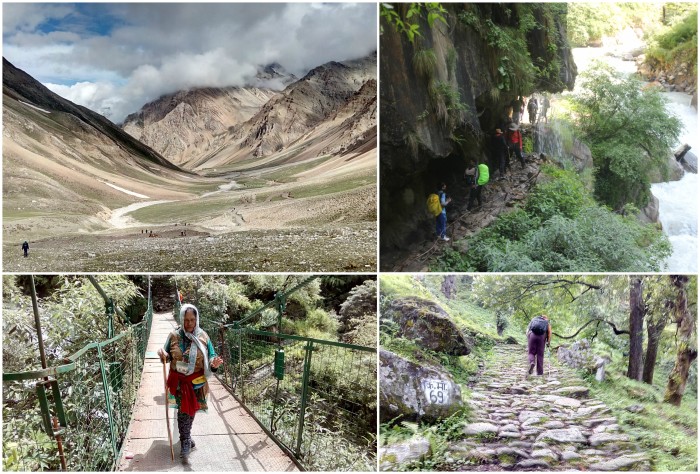“Nature is God, God is Nature”
Last year, I got introduced to this superb trekking route, which is a pilgrimage to The Holy Kailash Parvat and the Holy Manasarovar Lake, located in Tibet, China. It was straightaway put at the top of my ‘bucket list’, and after learning about the procedure to apply through the Ministry of External Affairs, I applied and was selected to be a participant for this year’s Kailash Manasarovar Yatra.
I had a lot of apprehensions about my packing for the 21 day trip, hygiene en route, room facilities, water quality, a group of unknown 55 people, etc. But then, as I always say and do – Go with the Flow.
Our batch being the first one leaving for the Kailash Manasarovar Yatra 2017, was flagged off by Smt. Sushma Swaraj, the Hon’ble Union Minister for External Affairs, with a note to promote the Swacch Bharat Abhiyan and not to sully the route leading to the holy place.
 Hon’ble Smt. Sushma Swaraj ji addressing the Kailash Manasarovar Yatries
Hon’ble Smt. Sushma Swaraj ji addressing the Kailash Manasarovar Yatries
June 12th, 2017 – Finally, I was leaving for The Kailash Manasarovar Yatra, the Pilgrimage of a Lifetime…!
The first night halt was at Almora, at the Kumaon Mandal Vikas Nigam owned Tourist Rest Home, with a breathtaking view of the valley and hills.
Next day, we had the chance to meet the humble King of Askot, Rajwar Bhanuraj Singh Pal. From the medieval times till the Sino-Indian war of 1962, all the arrangements for the Kailash Manasarovar Yatra were taken care of by the Royal Pal Dynasty of Askot State. We spoke about his family’s long centuries-old association with the Yatra, and also about the recent news of the development of five new hydro-projects in Askot. While dwelling more about hydropower project, we found state-owned NHPC is working out details for five run-of-the-river hydroelectric projects on the Gori and the Dhauli (the area was brought out of Askot wildlife sanctuary in 2013). Good as localities will get electricity but sad on environmental aspect, as this might affect the wildlife, topology of the land and river basin.
 Rajwar Bhanuraj Singh Pal
Rajwar Bhanuraj Singh Pal
Uttrakhand has always mesmerized me with its beauty (well deserved to be known as God’s land) being it 2017 or 2007.
 Surrounded with tall trees, beautiful flowers and mountain is Narayan Ashram
Surrounded with tall trees, beautiful flowers and mountain is Narayan Ashram
The on-foot 16 days trekking started from Narayan Ashram. Daily we encountered new challenges on new kinds of trekking paths, different aspects of life, new learnings from fellow yatris and interesting stories. Never thought connecting with nature and people outside my known social circle will be a blessing in its own way. Hiking through the jungle one day, the next day crossing a waterfall, another day trekking through a lush green valley, waking up early at 2.30 am and relying on my ears while walking through nature, all toughened me both mentally and physically. The mineral rich natural water springs were so pure and untouched, the water tasted a thousand times better than the RO water back home.
 Challenging tracks in Uttrakhand
Challenging tracks in Uttrakhand
Small villages that I crossed always made me realise how blessed the villagers were to spend each & every moment in this beautiful place ‘connected to nature’. It is worth appreciating how nature has provided for their livelihood in the form of fertile soil in the Himalayan terrain, from beautiful flowers to wild plants. The kids all along the route were playing in the real environment, in nature, with friends and pets, instead of being in the virtual world and busy chatting with online friends.
 Kids playing with/in nature
Kids playing with/in nature
But the dark side to be in this place is that these villagers are among the first to suffer when ecosystems are threatened, whether by pollution, climate change or over-exploitation, mostly by people like us who live in the plastic world or the so called Urbans.
Every year, a total of 18 batches comprising of 60 people each goes for this Yatra which starts in June and goes on till August. But this year, on August 13th, the Yatra came to a sudden halt after a cloudburst in the Mangta Nala and Malpa region of Uttarakhand. Seven people, including four soldiers, went missing, many houses, and a number of vehicles were buried in the debris due to floods and landslides. Malpa was the place where we had lunch, chit chat and have lots of fond memories. The frequency of such incidents is increasing because of climate change, sadly not many realise this (not even Donald Trump!).
With the freezing wind somehow managing to find its way to enter even six layers of my clothing, and with a shivering body, I stepped into Tibet, the land of snows, the land of Gods, and the land of revelations.
After our initial welcome in the town of Taklakot, I took a walk around the area. What is worth mentioning is that they have scaled up their renewable energy to unimaginable levels. Every nook and corner is installed with solar powered lights, homes are enabled with solar water heaters, and when we move out of the town, wind farms are distinct eye-catchers.
 Wind and Solar installation in Tibet
Wind and Solar installation in Tibet
On July 3rd 2017, we safely returned to Delhi. I consider myself lucky to be a part of the Kailash Manasarovar Yatra, and, I can relate even better with this year’s theme for the World Environment Day, which coincidently is about “Connecting People to Nature” (pushing people to think about how we are part of nature and how intimately we depend on it).
 (Clockwise) Mount Kailash, Monk, Manasarovar Lake, local pilgrims
(Clockwise) Mount Kailash, Monk, Manasarovar Lake, local pilgrims
The 21 days of clean air, fresh water, walking on different terrains, enduring extreme climatic conditions, moving up from just 3000 ft to over 18000 ft altitude, all this not just trains you physically, but challenges your mind and emotions too. Almost after a month of the ultimate travel experience, I believe the Kailash Manasarovar Yatra has bought “Inner Peace” in me.

 Hon’ble Smt. Sushma Swaraj ji addressing the Kailash Manasarovar Yatries
Hon’ble Smt. Sushma Swaraj ji addressing the Kailash Manasarovar Yatries Rajwar Bhanuraj Singh Pal
Rajwar Bhanuraj Singh Pal Surrounded with tall trees, beautiful flowers and mountain is Narayan Ashram
Surrounded with tall trees, beautiful flowers and mountain is Narayan Ashram Challenging tracks in Uttrakhand
Challenging tracks in Uttrakhand Kids playing with/in nature
Kids playing with/in nature Wind and Solar installation in Tibet
Wind and Solar installation in Tibet (Clockwise) Mount Kailash, Monk, Manasarovar Lake, local pilgrims
(Clockwise) Mount Kailash, Monk, Manasarovar Lake, local pilgrims Energy Efficiency (BEE) and efforts of Energy Efficiency Services Limited (EESL). Although the price of the energy efficient (EE) star labelled fans might seem high compared to their non-star fans, but if we look at ever rising electricity costs, and do little mathematics the payback will be within one summer (considering Rs. 5/unit). So opting for EE fans makes a lot of sense especially if you have high usage of fans (24×7).
Energy Efficiency (BEE) and efforts of Energy Efficiency Services Limited (EESL). Although the price of the energy efficient (EE) star labelled fans might seem high compared to their non-star fans, but if we look at ever rising electricity costs, and do little mathematics the payback will be within one summer (considering Rs. 5/unit). So opting for EE fans makes a lot of sense especially if you have high usage of fans (24×7).




 As per UNEP report 40 million metric tons (MT) of e-waste is produced annually in the world, most of which is illegally dumped or traded, and about 1.7 million MT is generated by India.
As per UNEP report 40 million metric tons (MT) of e-waste is produced annually in the world, most of which is illegally dumped or traded, and about 1.7 million MT is generated by India.